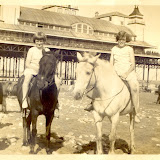An English photo album from the 1930s
"What good is running if one is on the wrong road?”
English proverb
There are 47 photographs in the album, none marked with any inscriptions to give a precise date or location but the clothes and the cars tell us it was the 1930s. A shot of the Royal Border Bridge in Berwick indicates some of the photographs were taken in the north of England, others look like they come from the Isle of Wight and Wales. The ruins, the church interiors and the façade of a very modern building suggest the photographer was interested in architecture and possibly an architect. But how much do we really need to know? Not a lot when the images stand up on their own. By all appearances they considered themselves a typical middle class family. Whatever ideas they had about England and the English character came from the same sources everyone drew on; not the big stories about the ruined economy or bleak inevitability of another war but minor details picked up in the newspapers that seemed so intrinsically British that they couldn’t happen anywhere else. The stories below were taken from newspapers published in the 1930s.
FEBRUARY 1930
Ghost hunting is the latest sport to take off in England. Hundreds gathered recently to hunt down a spectre seen floating about a house in Kent. They managed to flush out a tramp sleeping in the hedges but little else. Generally a medium will lead a party of ghost hunters to a site reputed to be haunted and attempt a scientific exposé. Recently a medium was observed undergoing a titanic psychic battle with an unseen spirit that left her unconscious. It has been reported that she has since died.
SEPTEMBER 1931
Every day for the last ten years the Prince of Wales has received a letter from the same, anonymous resident of Glasgow. Experts have determined the writer is most likely an elderly lady. Every letter begins. "My dear Prince," and then follows with a quote from the Book of Revelations. Nothing more is added.
FEBRUARY 1932
Her family evicted from its estates at Witton Castle,Lady Chaytor has hit upon a scheme for raising the money to meet the debts. She intends to fly a Gypsy Moth biplane to Australia next March, stopping off at all the major cities of the Commonwealth on the route in order to present lectures on fashion.
AUGUST 1933
Miss Ross, of West Hartlepool was exploring the caves at Marsden when she found a small mummified figure. It measured 12 inches and had dark wrinkled skin and two green glass eyes. She took the figure home and put it on the bookshelf shelf in her bedroom. The figure repeatedly fell to the ground despite having ample space. For reasons as yet unknown, Miss Ross' mother stabbed the figure with a hot knitting needle. The next day the woman was struck by a painful disease of the eye that has so far only been observed in the tropics.
OCTOBER 1934
For six weeks now the family in Finsbury has been living in terror of the mysterious night visitor. Twice the three children have been attacked in their sleep, waking up with puncture marks on their skin. The mother, Mrs Baines, says: "In the morning, I went in to the children and I found Marjorie, aged eight, and Eileen, aged seven, covered with blood. I found that Eileen had two small marks, half an inch apart, on her wrist. They were just like punctures, mauve in colour, and swollen. Marjorie had two just like it above her elbow.” Doctors are baffled.
JANUARY 1935
The inquest into the death of William Bollard of Norwood has heard that when police entered the house the four dogs guarding their owner’s body were so protective one had to be shot at once. Neighbours were curious as to why Bollard would live for fourteen years in the house, isolated from all company except his dogs. Some night the neighbours heard strangely beautiful music coming out of the house. When they peered through the window they saw Bollard sitting at a dusty grand piano.
NOVEMBER 1936
Richard Lambert, editor of the BBC Listener has won his case against Sir Cecil Levita and been awarded £7500 after the jury agreed Levita had defamed Lambert when he said the editor believed in the occult and was crazy. At best, Lambert asserts, he had expressed the same interest as many ordinary Britons in Gef the talking mongoose. The mongoose, which inhabits a farm in the Isle of Man, speaks English fluently as well as a smattering of Hebrew and Russian, although only to the Irvings, the owners of the farm. None of the hundreds of visitors to the farm have heard the mongoose utter so much as a squeak.
JUNE 1937
The Yorkshire mill-owner is wealthy enough to stay in one of the better hotels off Piccadilly when he visits London but he insists that the bed be removed so that he can sleep on the floor. The purest air is always nearest the floor, he claims.
SEPTEMBER 1938
Indra Shira and Captain Hubert Provand, both being keen amateur photographers, were asked by Lady Townshend to take pictures of Raynam Hall, especially the grand staircase at the entrance. Provand had his head under the black cloth and was focussing the camera when Shira saw an ethereal shape coming down the stairs. "Quick, quick, are you ready?" he called. "There is something on the staircase!" Provand opened the shutter and Shira fired his magnesium pistol. When the photograph was developed it revealed a spectral yet feminine form wafting down the stairs.
 |
| ENGLISH SNAPS |










No comments:
Post a Comment
Add comments here